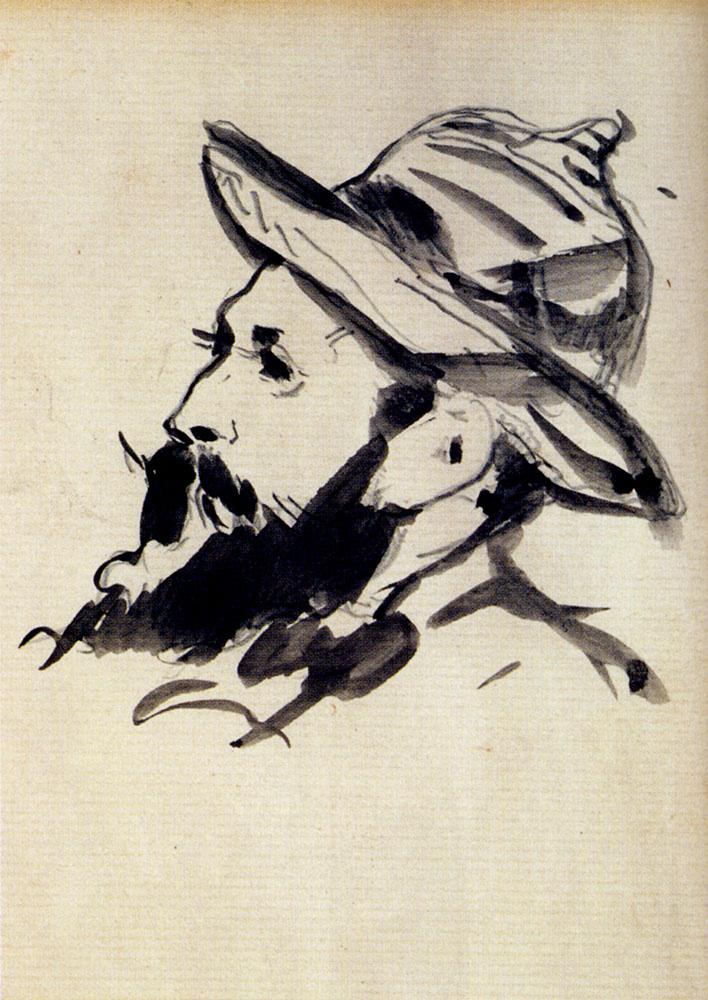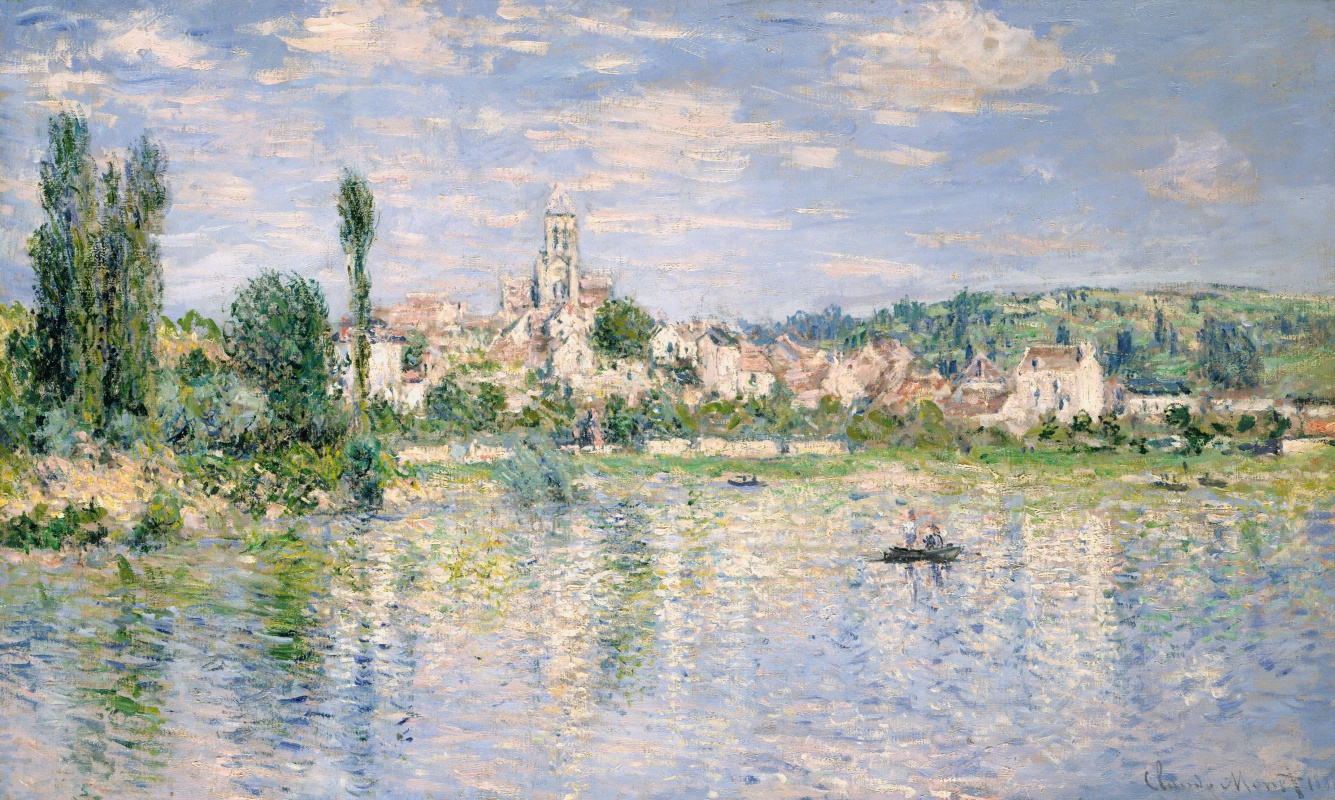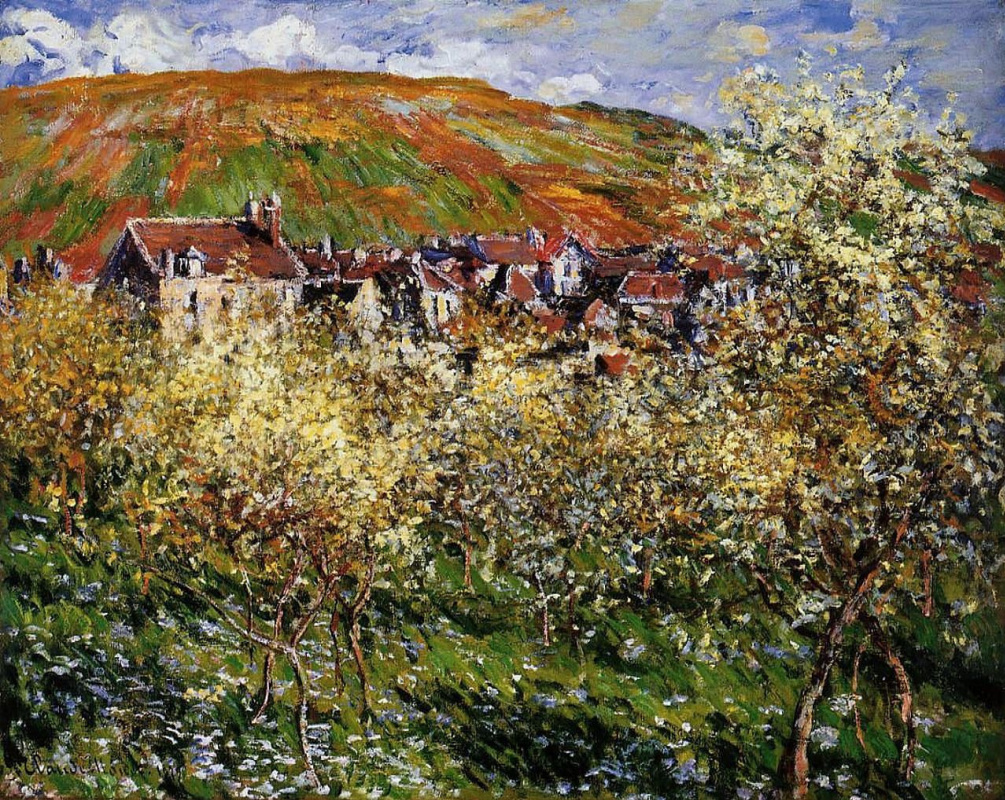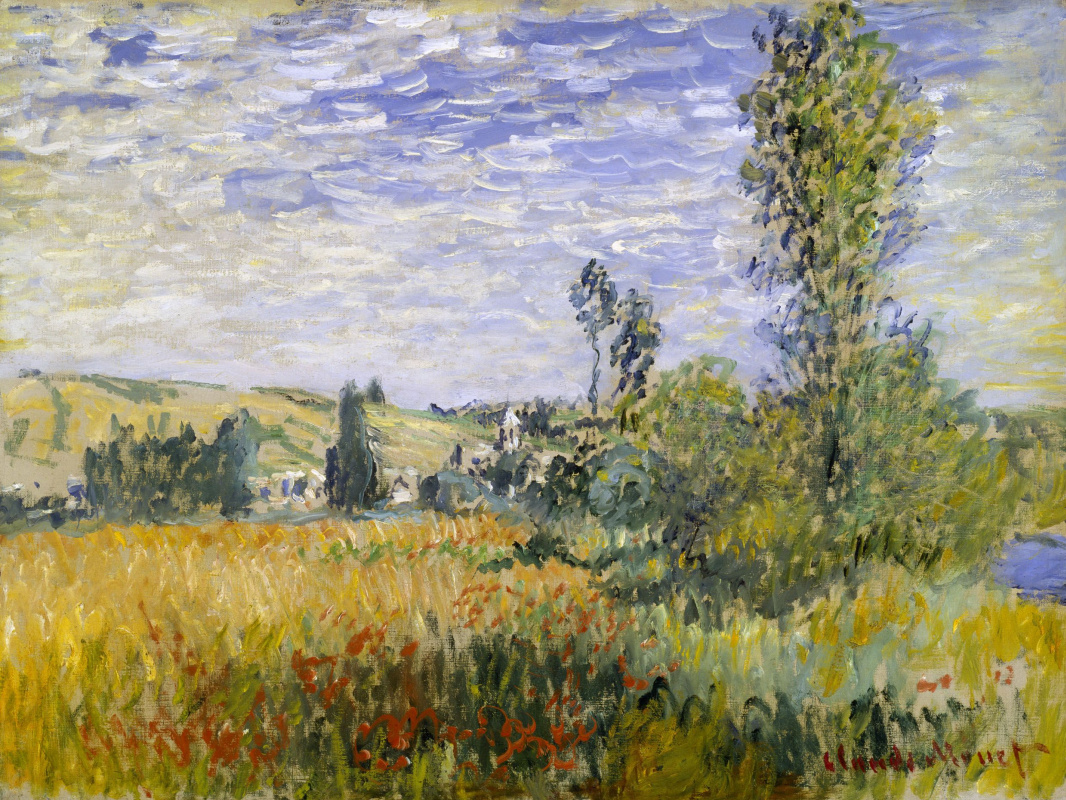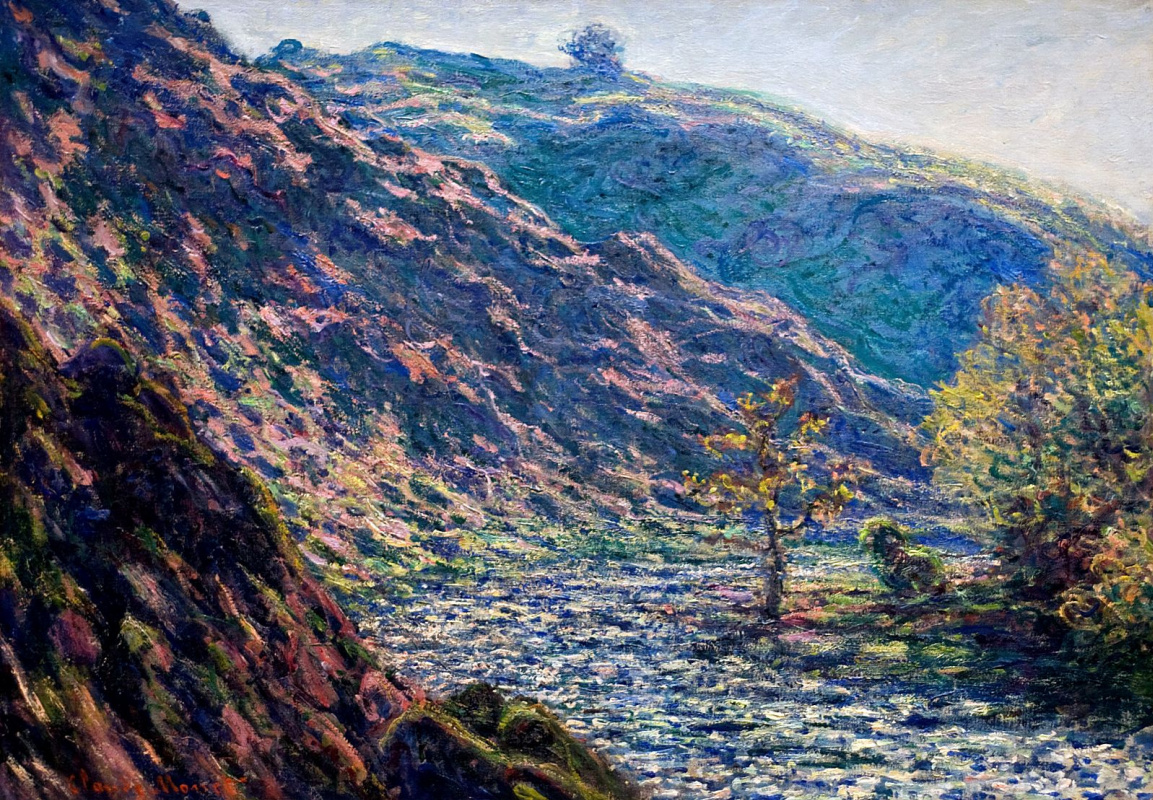To jump on a donkey over the fence of a military camp, to cut all leaves from an old oak tree, to divert a part of a river to create a pond, to quarrel with a friend and a loyal customer. If Claude Monet conceived something, it was difficult to stop him.

Head of a man (Claude Monet)
1874, 17×14 cm
Never learnt to ride a horse, Monet escaped from the army on a donkey. 20-year-old Monet could easily escape service in the army attracting no animals. His father was about to pay a fixed official amount to eliminate his son’s seven-year commitment. But Claude raved about Algeria, sands, a spectacular red-white-and-blue uniform and the burning sun, therefore he chose service in the First Regiment of African Light Cavalry.
For almost two years of his Algerian adventures, he never took part in a military campaign. A beautiful snow-white pom-pom on his red hat he was to wear only when walking down the manege, frankly speaking, to remove manure. Finally, Claude got so sick of cleaning toilets and vegetables that he revolted: jumped on a donkey, violently spurred it, and jumped over the fence of a camp.
Some time later, he was found without a donkey, in a fever, delirious by typhoid in an olive grove nearby. First he was sent to a punishment room, then to a hospital and finally home on vacation to mend. Under the warm sun of Le Havre, on a beach, the idea to pay a ransom for the remaining 5 years of service, seemed no longer silly to Claude and his military uniform looked no longer beautiful to him.
For almost two years of his Algerian adventures, he never took part in a military campaign. A beautiful snow-white pom-pom on his red hat he was to wear only when walking down the manege, frankly speaking, to remove manure. Finally, Claude got so sick of cleaning toilets and vegetables that he revolted: jumped on a donkey, violently spurred it, and jumped over the fence of a camp.
Some time later, he was found without a donkey, in a fever, delirious by typhoid in an olive grove nearby. First he was sent to a punishment room, then to a hospital and finally home on vacation to mend. Under the warm sun of Le Havre, on a beach, the idea to pay a ransom for the remaining 5 years of service, seemed no longer silly to Claude and his military uniform looked no longer beautiful to him.
Vétheuil in summer
1880, 60×99.7 cm
Sometimes Claude Monet flatly refused to sell his paintings. When the first Impressionist exhibition has provoked roars of laughter among visitors and inspired critics to produce the most refined and poisonous jokes, a few people in Paris still have seen the true art in a modern painting, and in the poor artists — future stars. One of the first judges of Impressionism was at that time a famous baritone of the Paris Opera Jean-Baptiste Faure, the best Don Juan and the Hamlet of Parisian scene.
One day, Faure peeked in a studio of Claude Monet to choose a painting for his collection. When maestro tumbled on a Vétheuil's view, he asked for its price. "Oh, no, my dear," Faure outraged when he heard the price in 50 francs, "It’s not even a painting! If I pay money, I want to pay it not for a piece of canvas, but for the painting!"
Several years have passed, and prices for Impressionist paintings began to accrete with zeros. Faure has already realized that not only he was buying a marvelous paining but also making a reasonable financial investment. "Six hundred? One thousand?" he tried to bargain for a study of a Vétheuil's view with Monet.
Monet was adamant: "Once you’ve refused to buy it for 50 francs, now you won’t get it even for 50 thousand. Go choose any other one!"
One day, Faure peeked in a studio of Claude Monet to choose a painting for his collection. When maestro tumbled on a Vétheuil's view, he asked for its price. "Oh, no, my dear," Faure outraged when he heard the price in 50 francs, "It’s not even a painting! If I pay money, I want to pay it not for a piece of canvas, but for the painting!"
Several years have passed, and prices for Impressionist paintings began to accrete with zeros. Faure has already realized that not only he was buying a marvelous paining but also making a reasonable financial investment. "Six hundred? One thousand?" he tried to bargain for a study of a Vétheuil's view with Monet.
Monet was adamant: "Once you’ve refused to buy it for 50 francs, now you won’t get it even for 50 thousand. Go choose any other one!"

Rodin and Monet at the Kunsthaus of Zurich | © Kunsthaus Zürich — Photo: www. jpg-factory.com
Discretion and diplomacy were not the virtues of Monet. Moreover, it is unlikely he believed these qualities to be virtues. He easily quarreled and reconciled to the closest friends, not ceasing to love them and appreciate.
Claude Monet and Auguste Rodin were close friends, genuinely admired each other professionally and continuously participated in joint exhibitions. Once Rodin was reluctant to arrange his work in time for one of these joint exhibitions at the Galerie Georges Petit. He rushed on the eve of the opening, and barely had time to place his sculpture in a room already prearranged.
"What have you done to my paintings? And nothing can be corrected! I knew it! Where have you hang my best canvas? Behind a row of your sculptures, where nobody can see it at all! This is a total disaster! Don’t even hope I’ll be at the exhibition! My legs will not be in here!" Monet was indignant. Most of his paintings were literally hidden behind the works of Rodin.
"I don’t give a damn about Monet! I don’t give a damn about the whole world! The only thing I’m worried about is me!" shouted Rodin, who actually was torn away from his job at that moment.
Both slammed the doors and departed: one has left for Giverny to paint haystacks, the other has gone to continue his work on the "The Gates of Hell".
But in the end, the Georges Petit exhibition was a triumph for both, restoring their friendship. Monet later wrote an introduction to Rodin’s catalogue and signed an open letter in his defense. Rodin, when first saw the ocean, exclaimed, "This is a Monet!"
Claude Monet and Auguste Rodin were close friends, genuinely admired each other professionally and continuously participated in joint exhibitions. Once Rodin was reluctant to arrange his work in time for one of these joint exhibitions at the Galerie Georges Petit. He rushed on the eve of the opening, and barely had time to place his sculpture in a room already prearranged.
"What have you done to my paintings? And nothing can be corrected! I knew it! Where have you hang my best canvas? Behind a row of your sculptures, where nobody can see it at all! This is a total disaster! Don’t even hope I’ll be at the exhibition! My legs will not be in here!" Monet was indignant. Most of his paintings were literally hidden behind the works of Rodin.
"I don’t give a damn about Monet! I don’t give a damn about the whole world! The only thing I’m worried about is me!" shouted Rodin, who actually was torn away from his job at that moment.
Both slammed the doors and departed: one has left for Giverny to paint haystacks, the other has gone to continue his work on the "The Gates of Hell".
But in the end, the Georges Petit exhibition was a triumph for both, restoring their friendship. Monet later wrote an introduction to Rodin’s catalogue and signed an open letter in his defense. Rodin, when first saw the ocean, exclaimed, "This is a Monet!"
The old tree at the mouth of the river
1889, 65×92 cm
Claude Monet commanded the rain, mists and seasons. Anyway, at least he managed to paint a winter landscape
at the height of the spring.
The artist spent all spring of 1889 in a house of his friend Maurice Rollinat. The valley Creuse has captured Monet completely: two boiling streams in a rocky gorge merged here into the one, and a lonely, old, thickset oak tree grew on its banks. The artist made his first sketches of the mighty tree at the end of February, and decided to finish his job in May. But oak, unfortunately, had overgrown with leaves.
A few days of searching for the landlord, 50 francs, two workers and long ladders dragged with their superhuman efforts managed to give the oak tree its spring outlook. The tree looked just as in February.
"I'm going to offer fifty francs to my landlord to see if I can have the oak tree’s leaves removed… Isn’t it the final straw to be finishing a winter landscape at this time of year," Claude wrote in a letter to his wife.
The artist spent all spring of 1889 in a house of his friend Maurice Rollinat. The valley Creuse has captured Monet completely: two boiling streams in a rocky gorge merged here into the one, and a lonely, old, thickset oak tree grew on its banks. The artist made his first sketches of the mighty tree at the end of February, and decided to finish his job in May. But oak, unfortunately, had overgrown with leaves.
A few days of searching for the landlord, 50 francs, two workers and long ladders dragged with their superhuman efforts managed to give the oak tree its spring outlook. The tree looked just as in February.
"I'm going to offer fifty francs to my landlord to see if I can have the oak tree’s leaves removed… Isn’t it the final straw to be finishing a winter landscape at this time of year," Claude wrote in a letter to his wife.
Garden path
1901, 92×89 cm
Claude Monet was ready to fight for his flower garden. He used everything he could: eloquence, money, fame that came to rescue in time, persuasion, threats, broad gestures, tricks.
Once in Giverny, everybody was enliven by a good news: some businessman decided to build a small factory to produce starch on a local swamp. It was a lucky strike for everybody: local villagers would get the job, municipal council would obtain money. But not for Monet! A factory? Just opposite the windows of Claude Monet’s pink house? Heck, no! He scribbled letters to the mayor, his deputy, town council, but got refusals in return. So, Monet came in person and offered: "If you want I’ll buy the swamp myself. It will remain in the possession of the town, and the money will be spent on its improvement." He just wanted to make them swear that it would not be sold over the next 15 years.
The other day Giverny locals resisted selling a plot of land to the insane artist because of a stream that was running through it. They were afraid that he might pollute the water and their livestock would die. But it turned out that the city freak wanted even more: to dig a pool and feed it by a channel diverted from the river. They thought he would leave them without any water at all!
Monet exploded to their formidable resistance, "To hell with the natives and the engineers!" He would have spitted at all and left the cursed place! In the end, however, he calmed down and wrote another letter to the mayor telling that the channel would be quite small, the stream would not be affected, the pond was meant to be small with only two very tiny suspension bridges. And again he has won!
When perspective of his garden seemed to Monet not deep enough, he went to a neighbor and bought a strip of land paying her fantastic amount. When he noticed that the dust from a road nearby falls on his flowers, he made the town council to cover the road with asphalt and paid half of the required amount for it. His garden was his sweetest, his most demanding, most capricious, and most intimate passion.
P.S. A separate book can be written about stubbornness of Claude Monet. He flatly refused to use a phone, which came up in Giverny, and instead wrote notes to Georges Clemenceau who lived nearby. All his life he cut into pieces, drawn, stomped with his feet paintings which he considered failed. Just as stubbornly, he hasn’t recognized electric light and bursted out laughing when he’s heard an offer to become a member of the French Academy of Fine Arts. "Old maitre remains in Giverny, because he prefers the greenery foliage to a green tail coat," wrote in Le Figaro.
Once in Giverny, everybody was enliven by a good news: some businessman decided to build a small factory to produce starch on a local swamp. It was a lucky strike for everybody: local villagers would get the job, municipal council would obtain money. But not for Monet! A factory? Just opposite the windows of Claude Monet’s pink house? Heck, no! He scribbled letters to the mayor, his deputy, town council, but got refusals in return. So, Monet came in person and offered: "If you want I’ll buy the swamp myself. It will remain in the possession of the town, and the money will be spent on its improvement." He just wanted to make them swear that it would not be sold over the next 15 years.
The other day Giverny locals resisted selling a plot of land to the insane artist because of a stream that was running through it. They were afraid that he might pollute the water and their livestock would die. But it turned out that the city freak wanted even more: to dig a pool and feed it by a channel diverted from the river. They thought he would leave them without any water at all!
Monet exploded to their formidable resistance, "To hell with the natives and the engineers!" He would have spitted at all and left the cursed place! In the end, however, he calmed down and wrote another letter to the mayor telling that the channel would be quite small, the stream would not be affected, the pond was meant to be small with only two very tiny suspension bridges. And again he has won!
When perspective of his garden seemed to Monet not deep enough, he went to a neighbor and bought a strip of land paying her fantastic amount. When he noticed that the dust from a road nearby falls on his flowers, he made the town council to cover the road with asphalt and paid half of the required amount for it. His garden was his sweetest, his most demanding, most capricious, and most intimate passion.
P.S. A separate book can be written about stubbornness of Claude Monet. He flatly refused to use a phone, which came up in Giverny, and instead wrote notes to Georges Clemenceau who lived nearby. All his life he cut into pieces, drawn, stomped with his feet paintings which he considered failed. Just as stubbornly, he hasn’t recognized electric light and bursted out laughing when he’s heard an offer to become a member of the French Academy of Fine Arts. "Old maitre remains in Giverny, because he prefers the greenery foliage to a green tail coat," wrote in Le Figaro.
Written by Anna Sidelnikova.






